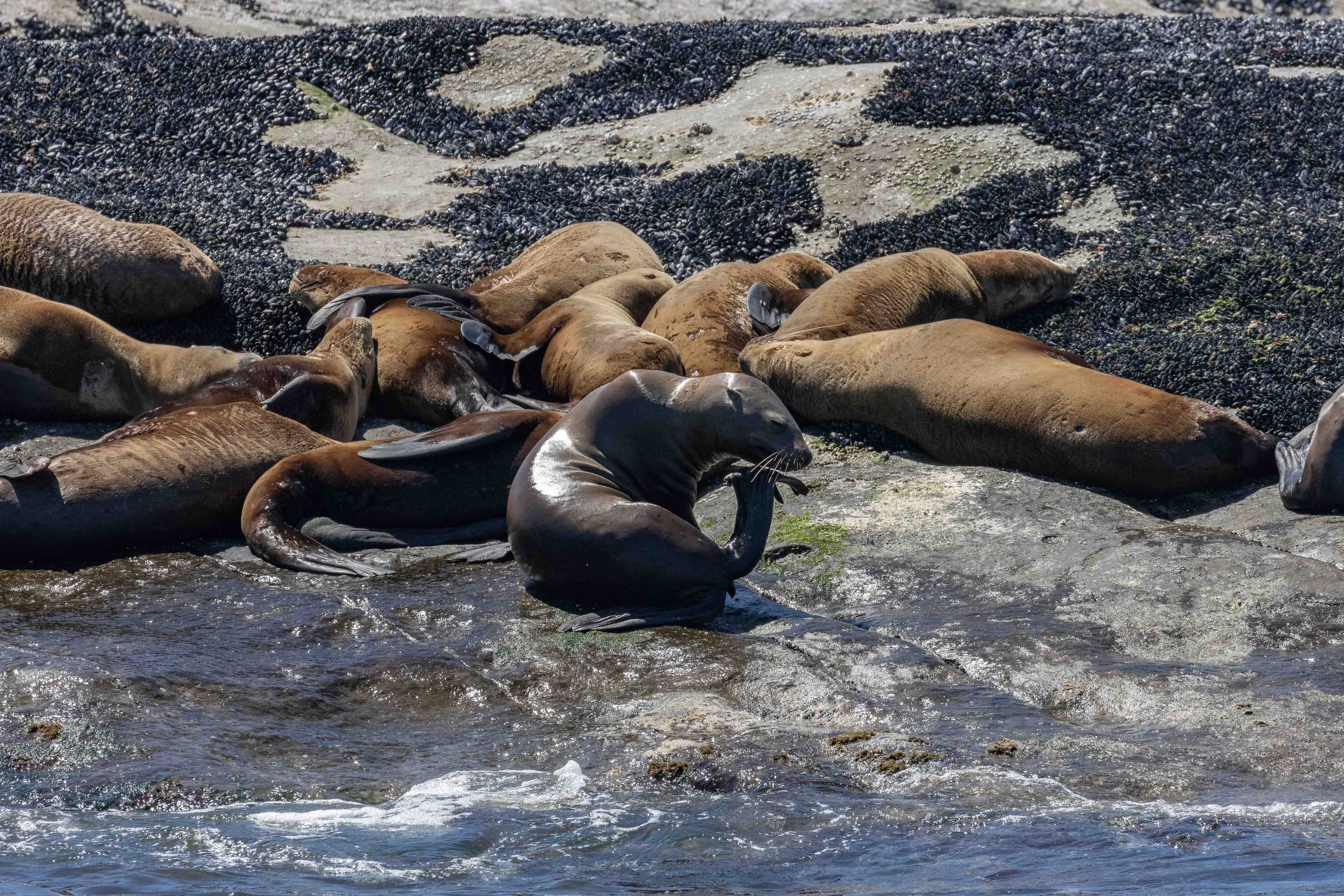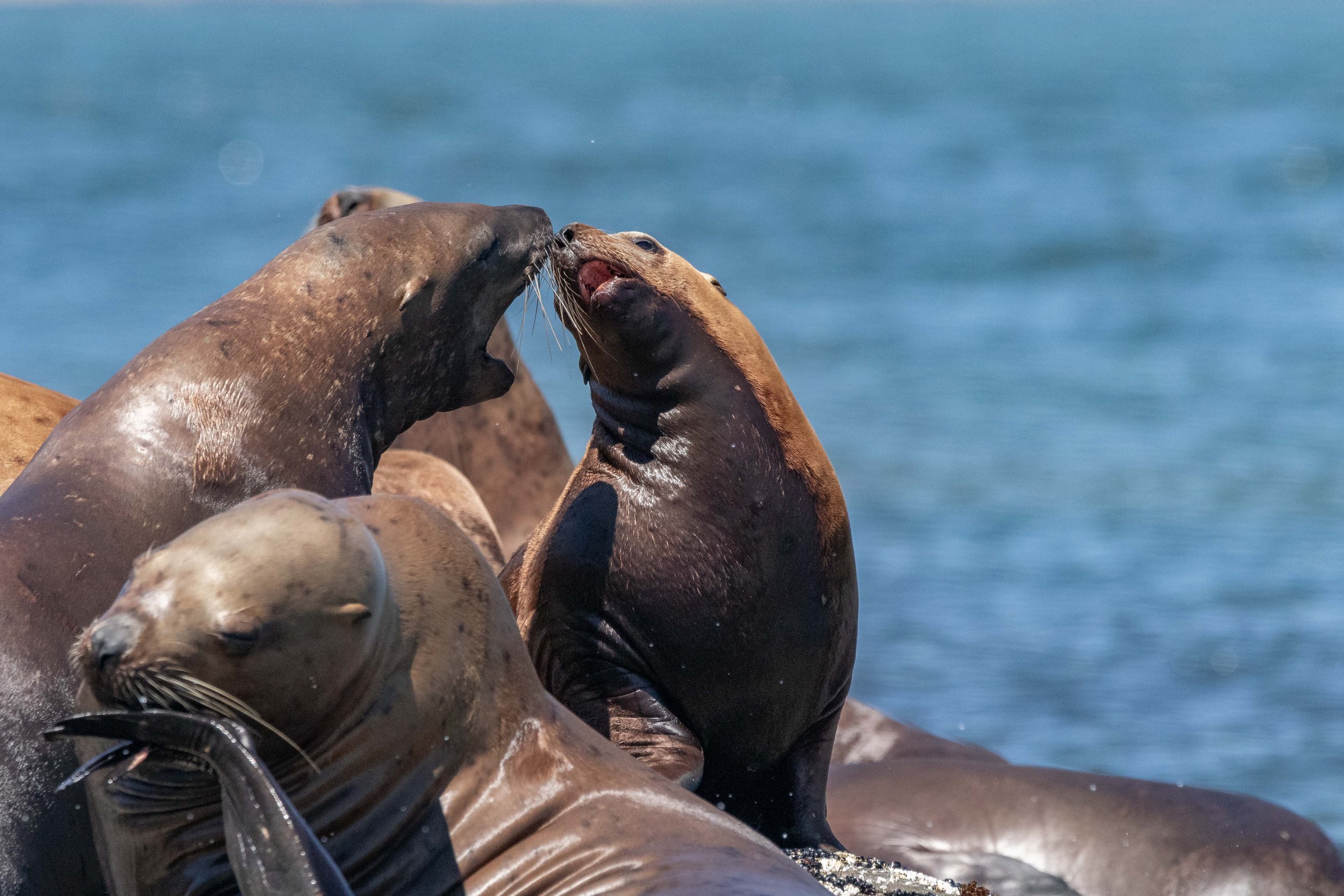July 9, 2024, 10:30 AM - Spending Time with 5 Humpback Whales in the Strait of Georgia
It was another beautiful sunny day as we loaded our guests into our three boats, looking to beat the heat by getting out on the water in search of whales! It’s a great choice since it’s usually about 5-10 degrees cooler on the water than on land. We had all three of our boats out this morning, and they spread out and headed into the Strait of Georgia to see what was in store for us today! It didn’t take long before we spotted the blow of a humpback whale in the distance. We headed over there and found a single whale feeding in the area. They lifted their tail high, showing off a very plain black fluke. There are three different classifications of flukes in BC: X, Y, and Z.
X Whales have nearly the entire underside of their tails being black, with a maximum of about 20% white pigmentation. These darkly coloured whales are the most common to see in BC and other parts of the northern hemisphere. Down south though, there is a prevalence of lighter-coloured flukes!
Y Whales have anywhere from 20-80% white pigmentation and are perhaps the easiest to ID since that white usually makes striking patterns on the flukes which we can use to match against the catalogue.
Finally, there are Z-type whales, which you might be able to guess what they look like! Nearly the entire bottom of their tail is white (over 80% of the area) and they are the most rare to see around here.
This whale was definitely an X-whale, so we started the search there and figured out it was Incognito (BCX2053)! Incognito is named since he has a very clean fluke, meaning there’s no major scars or divots in the tail, which means he often avoids being IDed. Luckily the more time you spend with the whales, the more you learn to recognize even the less conspicuous whales like Incognito. We spent some time with this whale as he was travelling until we got word that there were more whales spotted nearby, so we decided to leave Incognito behind and found ourselves with a group of 3 whales travelling together this time.
These whales were also lifting their tails to dive and we were able to ID them as Smiley (BCY0995), Split Fluke (BCX1068), and Crater (BCX1565) travelling closely together. Crater was particularly easy given that they have a very distinctly “cratered” dorsal fin! It’s always interesting to see whales travelling closely together like this since it was once thought that they weren’t particularly social animals. As time goes on that seems to be changing since it’s becoming more common to see them in pairs or larger groups as opposed to them travelling alone. More research is being done to figure out what benefits may come from pairing up, but for now, we just enjoy seeing them like this! Socialization seems to be one of the leading theories, especially with females who are known to closely associate with each other on a longer scale when they are pregnant! Could Smiley and Split Fluke, both known females, be pregnancy buddies this year?
At one point during the encounter, one of these whales got a little more excited than the others, and we saw them breach out of the surface of the water! One was a “full breach” throwing the entire body out of the water while the other turned into a chin slap, with just the head leaving the water and striking down on the water’s surface with its ventral side. It’s still mostly unknown as to why the whales will do surface activity like this, but there are some theories such as knocking off parasites, using the noise for long-distance communication, and just for fun!
It became time to leave these whales to their rest now, and we started the journey back towards Nanaimo. Two of our boats ended up running into one more whale on the way to the other wildlife, which was Beak (BCX1606)! He was also just travelling in the area. Since we were so low on time, we only stayed for a couple of surfaces before continuing on to Stinky Rocks. Here we were greeted by a herd of Steller Sea Lions that were using the rocks to rest from the water and sun themselves. There was a fair bit of commotion as one of the large males stood tall, roaring at the rest of the sea lions. he then decided to run down the rock and dive into the water, perhaps just as sick of the heatwave as the rest of us!
There was something else pretty special further down the rocky shoreline, a freshly born seal pup! This was so new that we could still see the umbilical cord attached to their belly button. This umbilical cord will keep its pink, fleshy colouration for up to 4 days, but will start to dry out after that, changing its appearance. It can stay attached for up to 10 days! It was lying there beside its mom, both seeming happy to be now resting in the sunshine.
Continuing from here, one boat was treated to something else that was pretty cool, a Deer that was wading in the shallows near Gabriola Pass.
We made one final stop before returning to the harbour along the sandstone cliffs of Gabriola Island. Here we got to see Greyson, the young bald eagle, hopping around in branches from his nest as well as some nesting cormorants in the Cliffs themselves.
Finally, we returned to Nanaimo, happy with all the wildlife we had seen during the tour. The onboard naturalists Aly Kohman, Hayleigh Hilbert, and Vanessa Vereschahen captured some great photos, all of which are included below!
Incognito going for a dive. Photo by Hayleigh Hilbert.
Incognito arching his back to prepare to dive. Photo by Aly Kohlman.
Incognito raising his tail to dive. Photo by Aly Kohlman.
Incognito arching their back to dive. Photo by Vanessa Vereschahen.
Crater, Smiley, and Split Fluke surfacing together. Photo by Aly Kohlman.
Crater’s rostrum lifting out of the water in front of Smiley. Photo by Hayleigh Hilbert.
Split Fluke and smiley surfacing, and Crater lifting his rostrum in the back. Photo by Vanessa Vereschahen.
There is lots of variation in the dorsal fins of the humpback whales, Smiley here has a very hooked dorsal fin. Photo by Aly Kohlman.
Of of the humpbacks doing a chin slap. Photo by Aly Kohlman.
A nice big breach from on of the humpback whales (likely Smiley). Photo by Aly Kohlman.
Likely Smiley landing from a breach. Photo by Aly Kohlman.
The downside of a big zoom lens! Photo by Vanessa Vereschahen.
Split Fluke doing a tail flick! Photo by Aly Kohlman.
The underside of Craters tail as he goes for a dive. Photo by Hayleigh Hilbert.
Smiley lifting her tail for a dive. Photo by Hayleigh Hilbert.
Split Fluke (back) and Smiley preparing to dive together. Photo by Aly Kohlman.
Split Fluke as she dives. Photo by Vanessa Vereschahen.
The underside of Smiley’s tail flukes, can you see the joker smile she is named for in the pattern? Photo by Aly Kohlman.
A lovely high fluke from Split Fluke. Photo by Vanessa Vereschahen.
A little jellyfish floating by as we watched the whales. Photo by Vanessa Vereschahen.
Smiley surfacing in the calm water. Photo by Vanessa Vereschahen.
Smiley, Split Fluke, and Crater surfacing together with the coastal mountains in the background. Photo by Aly Kohlman.
Smiley arching her back for a dive. Photo by Vanessa Vereschahen.
Happy guests watching the humpback from open boat Keta. Photo by Hayleigh Hilbert.
More Happy guests, this time on open boat Cascadia. Photo by Hayleigh Hilbert.
Our semi-covered boat guests watching the whales. Photo by Vanessa Vereschahen.
Beak lifting his tail high to go for a dive. Photo by Aly Kohlman.
Look at the long whiskers of this Steller Sea Lion. Photo by Aly Kohlman.
This large male Steller Sea Lion towers over the others. Photo by Aly Kohlman.
Can you spot their tiny tail as this Steller Sea Lion climbs out of the water? Photo by Aly Kohlman.
These sea lions can be quite boisterous. Photo by Aly Kohlman.
The big male decided to go for a dip. Photo by Hayleigh Hilbert.
An itchy Sea Lion on the rocks. Photo by Hayleigh Hilbert.
Fighting sea lions on Stinky Rocks. Photo by Vanessa Vereschahen.
Look at those big teeth! Photo by Vanessa Vereschahen.
A freshly born baby Harbour Seal. Can you spot the umbilical cord? Photo by Aly Kohlman.
Mom and pup side by side. Doesn’t she look proud? Photo by Aly Kohlman.
The Baby Harbour Seal. Photo by Vanessa Vereschahen.
This bald eagle is taking off from the marker. Photo by Aly Kohlman.
The remaining Bald Eagle as the other flew away in the distance. Photo by Hayleigh Hilbert.
A rare sight on the tours, an intertidal deer! Photo by Hayleigh Hilbert.
Was this deer trying to cool off, or just looking for a snack? Photo by Hayleigh Hilbert.
Greyson hiding in the shade. Photo by Aly Kohlman.
A Bald Eagle panting to try and cool down. Photo by Hayleigh Hilbert.
More intertidal critters hanging from the Bluffs. Photo by Hayleigh Hilbert.
A Turkey Vulture riding the thermals overhead. Photo by Hayleigh Hilbert.
Cormorants tending to their nests. Photo by Aly Kohlman.















































